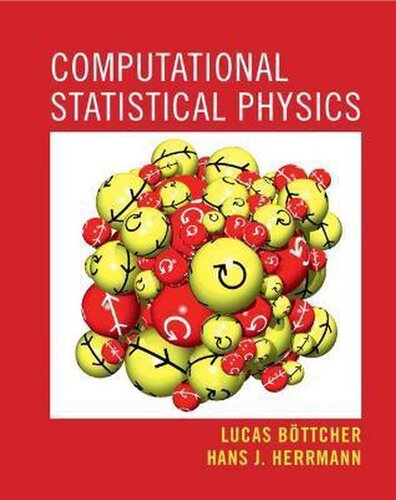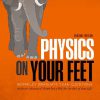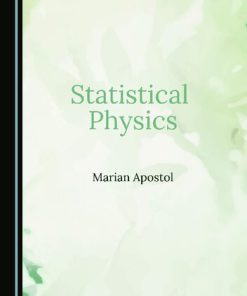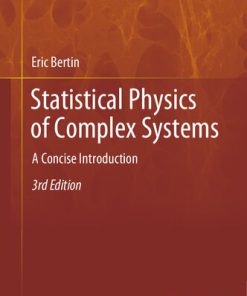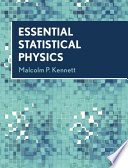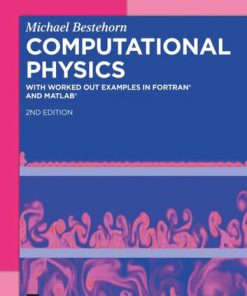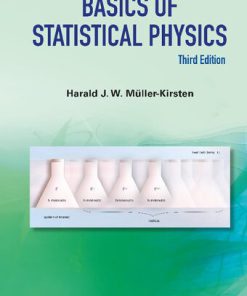Computational Statistical Physics 1st Edition by Hans 9781108896658 1108896650
$50.00 Original price was: $50.00.$25.00Current price is: $25.00.
Computational Statistical Physics 1st Edition Hans J. Herrmann – Ebook Instant Download/Delivery ISBN(s): 9781108896658, 1108896650
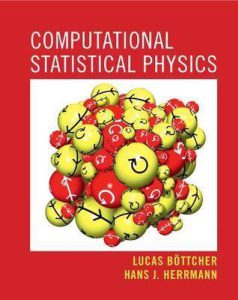
Product details:
- ISBN 10:1108896650
- ISBN 13:9781108896658
- Author: Hans
Computational Statistical Physics
Table contents:
What is Computational Physics?
Part I Stochastic Methods
1 Random Numbers
1.1 Definition of Random Numbers
1.2 Congruential RNG (Multiplicative)
1.3 Lagged Fibonacci RNG (Additive)
1.4 Available Libraries
1.5 How Good is an RNG?
1.6 Nonuniform Distributions
2 Random-Geometrical Models
2.1 Percolation
2.2 The Sol–Gel Transition
2.3 The Percolation Model
2.4 Fractals
2.5 Walks
2.6 Complex Networks
3 Equilibrium Systems
3.1 Classical Statistical Mechanics
3.2 Ising Model
4 Monte Carlo Methods
4.1 Computation of Integrals
4.2 Integration Errors
4.3 Hard Spheres in a Box
4.4 Markov Chains
4.5 M(RT)[sup(2)] Algorithm
4.6 Glauber Dynamics (Heat Bath Dynamics)
4.7 Binary Mixtures and Kawasaki Dynamics
4.8 Creutz Algorithm
4.9 Boundary Conditions
4.10 Application to Interfaces
5 Phase Transitions
5.1 Temporal Correlations
5.2 Decorrelated Configurations
5.3 Finite-Size Scaling
5.4 Binder Cumulant
5.5 First-Order Transitions
6 Cluster Algorithms
6.1 Potts Model
6.2 The Kasteleyn and Fortuin Theorem
6.3 Coniglio–Klein Clusters
6.4 Swendsen–Wang Algorithm
6.5 Wolff Algorithm
6.6 Continuous Degrees of Freedom: The n-Vector Model
7 Histogram Methods
7.1 Broad Histogram Method
7.2 Flat Histogram Method
7.3 Umbrella Sampling
8 Renormalization Group
8.1 Real Space Renormalization
8.2 Renormalization and Free Energy
8.3 Majority Rule
8.4 Decimation of the One-Dimensional Ising Model
8.5 Generalization
8.6 Monte Carlo Renormalization Group
9 Learning and Optimizing
9.1 Hopfield Network
9.2 Boltzmann Machine Learning
9.3 Simulated Annealing
10 Parallelization
10.1 Multispin Coding
10.2 Vectorization
10.3 Domain Decomposition
11 Nonequilibrium Systems
11.1 Directed Percolation and Gillespie Algorithms
11.2 Cellular Automata
11.3 Irreversible Growth
Part II Molecular Dynamics
12 Basic Molecular Dynamics
12.1 Introduction
12.2 Equations of Motion
12.3 Contact Time
12.4 Verlet Method
12.5 Leapfrog Method
13 Optimizing Molecular Dynamics
13.1 Verlet Tables
13.2 Linked-Cell Method
14 Dynamics of Composed Particles
14.1 Lagrange Multipliers
14.2 Rigid Bodies
15 Long-Range Potentials
15.1 Ewald Summation
15.2 Particle-Mesh Method
15.3 Reaction Field Method
16 Canonical Ensemble
16.1 Velocity Rescaling
16.2 Constraint Method
16.3 Nosé–Hoover Thermostat
16.4 Stochastic Method
16.5 Constant Pressure
16.6 Parrinello–Rahman Barostat
17 Inelastic Collisions in Molecular Dynamics
17.1 Restitution Coefficient
17.2 Plastic Deformation
17.3 Coulomb Friction and Discrete Element Method
18 Event-Driven Molecular Dynamics
18.1 Event-Driven Procedure
18.2 Lubachevsky Method
18.3 Collision with Perfect Slip
18.4 Collision with Rotation
18.5 Inelastic Collisions
18.6 Inelastic Collapse
19 Nonspherical Particles
19.1 Ellipsoidal Particles
19.2 Polygons
19.3 Spheropolygons
20 Contact Dynamics
20.1 One-Dimensional Contact
20.2 Generalization to N Particles
21 Discrete Fluid Models
21.1 Lattice Gas Automata
21.2 Lattice Boltzmann Method
21.3 Stochastic Rotation Dynamics
21.4 Direct Simulation Monte Carlo
21.5 Dissipative Particle Dynamics
21.6 Smoothed Particle Hydrodynamics
22 Ab Initio Simulations
22.1 Introduction
22.2 Implementation of Wave Functions
22.3 Born–Oppenheimer Approximation
22.4 Hohenberg–Kohn Theorems
22.5 Kohn–Sham Approximation
22.6 Hellmann–Feynman Theorem
22.7 Car–Parrinello Method
References
Index
People also search:
computational statistical physics
computational statistical physics pdf
computational methods in statistical physics
what is statistical physics
is statistics used in physics
You may also like…
Uncategorized
Mathematics - Mathematical Physics
Computational Physics 2nd Edition by Darren Walker 168392830X 9781683928300
Physics - Others
Statistical Physics of Complex Systems 3rd Edition Eric Bertin
Physics - Atomic & Molecular
Modern Physics: Introduction to Statistical Mechanics, Relativity, and Quantum Physics Salasnich
Physics - General Courses
Computational Physics 2nd Edition by Michael Bestehorn 9783110782660 3110782669
Uncategorized
Basics of Statistical Physics 3rd Edition by Harald J .W. Müller-Kirsten 9811256098 9789811256097
Computers - Programming
Introduction to Computational Physics with examples in Julia Gerson J. Ferreira

